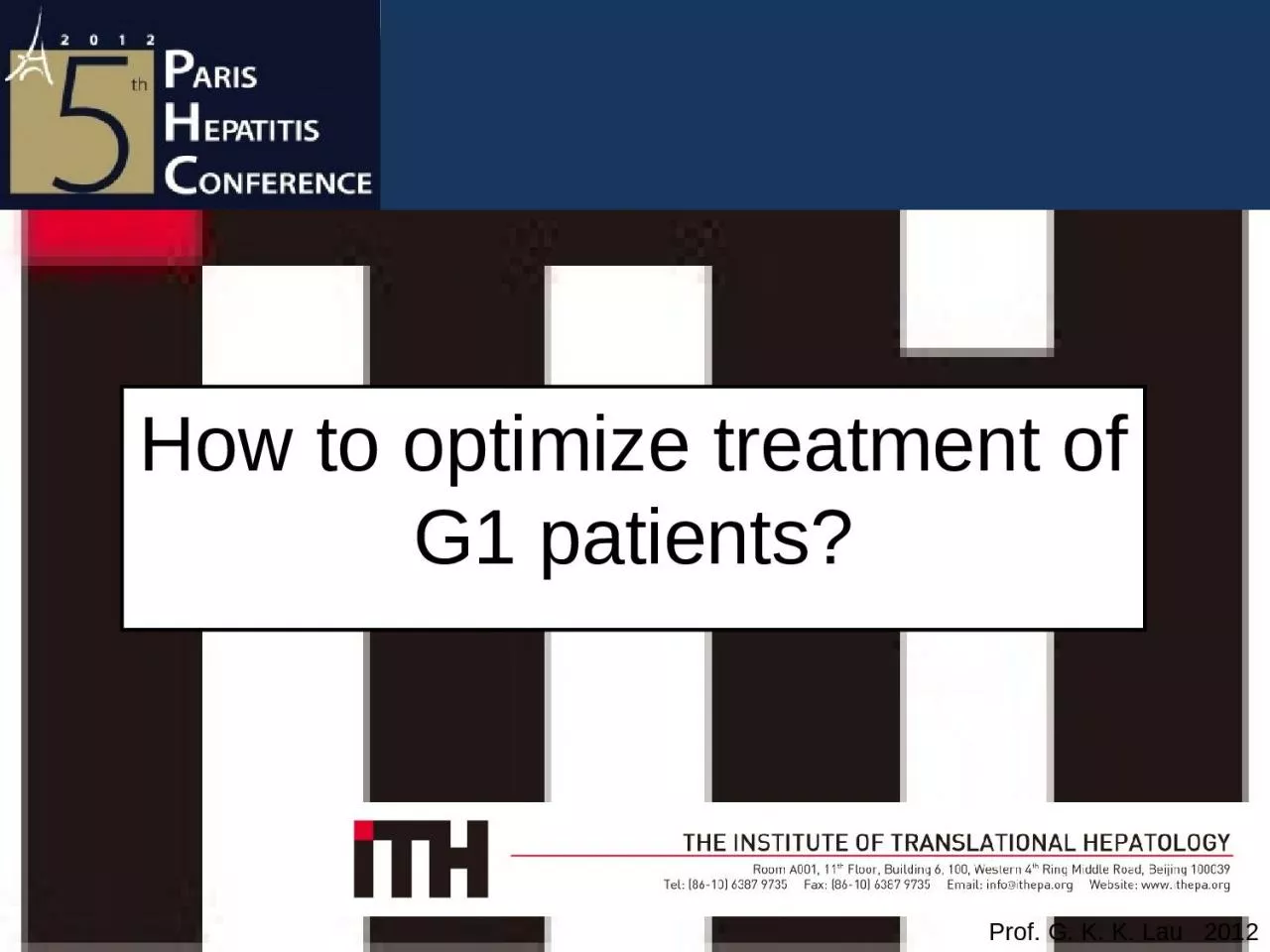

Prof G K K Lau 2012 Standard of care SOC for chronic HCV infection Peginterferon PegIFN ribavirin RBV 48 weeks HCV G1 4 5 and 6 24 weeks HCV G2 and 3 Induce sustained ID: 932181
Download Presentation The PPT/PDF document "How to optimize treatment of G1 patients..." is the property of its rightful owner. Permission is granted to download and print the materials on this web site for personal, non-commercial use only, and to display it on your personal computer provided you do not modify the materials and that you retain all copyright notices contained in the materials. By downloading content from our website, you accept the terms of this agreement.
Slide1
How to optimize treatment of G1 patients?
Prof. G. K. K. Lau 2012
Slide2Standard of care (SOC) for chronic HCV infectionPeginterferon (
PegIFN) + ribavirin (RBV)48 weeks (HCV G1, 4, 5 and 6)24 weeks (HCV G2 and 3)
Induce sustained virologic
response (SVR) rates (associated with long-term clearance of HCV infection)40-50% (G1)>80% (G2 and 3)
Two major advances
Direct-acting antiviral (DAA) agentsSingle-nucleotide polymorphisms
Prof. G. K. K. Lau 2012
Introduction
Slide3Five distinct drug classes currently under developmentThe only drugs approved by FDA at present
Inhibitors of the HCV non-structural protein 3/4A (NS3/4A) serine proteaseInhibits HCV replication and virion
assemblyBoceprevir
(BOC)Telaprevir (TVR)Monotherapy
: rapid development of drug resistance
Combination therapies (with PegIFN and RBV) lower drug resistance and improves antiviral response.
Prof. G. K. K. Lau 2012
DAA Agents
Slide4BOC /TVR in combination with PegIFN-α and RBV have
shown great improvement on SVR compared to SOC
For Treatment Naïve Patients
Four weeks lead-in treatment, PegIFN-α and RBV only; BOC 800 mg (with food), 3 times/day with
PegIFN
-α and RBV (24-44 weeks)TVR 750 mg (with food), 3 times/day with PegIFN-α and RBV (12 weeks) + 12-36 weeks of
PegIFN and RBV
Prof. G. K. K. Lau 2012
Optimal treatment for CHC G1
(Naïve Patients)
Slide5Patients without cirrhosis (BOC/PegIFN/RBV treated)
HCV RNA undetectable at weeks 8 and 24Shortened duration of treatment (28 weeks: 4 weeks lead-in + 24 weeks of combination therapy)
Patients without cirrhosis (TVR/
PegIFN/RBV treated)HCV RNA undetectable at weeks 4 and 12
Shortened duration of treatment (24 weeks)
Patients with cirrhosis 48 weeks therapy regardless of drug use (BOC/TVR + PegIFN
+ RBV)
Prof. G. K. K. Lau 2012
Optimal treatment for CHC G1
(Naïve Patients)
Slide6Treatment termination (patients without cirrhosis)HCV RNA level >100 IU/mL at week 12 or detectable at week 24
Treatment termination (patients with cirrhosis)HCV RNA level >1000 IU/mL at week 4 or 12 and/or detectable at week 24
Prof. G. K. K. Lau 2012
Optimal treatment for CHC G1
(Naïve Patients)
Slide7Virological relapse / partial responders after a prior course of treatment with
PegIFN-α and/or RBV Re-treatment with BOC/TVR +
PegIFN-α and/or RBV
Re-treatment with TVR/PegIFN-α /RBV for prior null responders to standard
PegIFN
-α/RBV therapyResponse-guided therapy using BOC/TVR based treatments cannot be recommended for null responder
Prof. G. K. K. Lau 2012
Optimal treatment for CHC
G1
(Patients
Previously Received Therapy)
Slide8Treatment termination (BOC/PegIFN
alfa/RBV)
HCV RNA level >100 IU/mL at week 12
High chance of antiviral resistance developmentTreatment termination (TVR/PegIFN
alfa/RBV)HCV RNA level >1000 IU/mL at week 4 or 12
High chance of antiviral resistance development
Prof. G. K. K. Lau 2012
Optimal treatment for CHC
G1
(Patients
Previously Received Therapy)
Slide9IL28B genotypePretreatment predictor of SVR to PegIFN
alfa, RBV and protease inhibitor therapy (CHC G1)Testing for additional information on possible treatment response or probable treatment duration needed
Prof. G. K. K. Lau 2012
Role of IL28B Testing
Slide10Adverse events, e.g. AnemiaShould reduce RBV dose / terminate treatmentVirological
breakthrough (>1 log increase in serum HCV RNA above nadir)Protease inhibitors therapy should be discontinuedDrug-Drug interactions (affects pharmacokinetic parameters)
Patients who: Fail to have virological
response/Experience virological breakthrough/Relapse on protease inhibitorShould not receive re-treatment with other protease inhibitor
TVR and BOC are not recommended for patients under 18 years of age (safety and efficacy concerns)
Prof. G. K. K. Lau 2012
Other complications
Slide11BOC and TVR are promising agents for improved SVR in CHC G1 patientsBOC/TVR + PegIFN
-α/RBV combination therapies have shown great improvement on SVR compared to SOCMany complex treatment issues remain to be solved Further phase 2 and 3 testing required
AsianGenotype/subtype
Prof. G. K. K. Lau 2012
Closing Remarks
Slide12